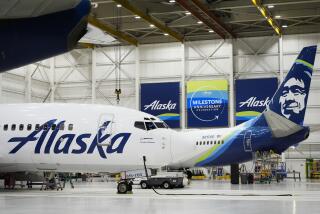Door Cracks on 747 Recur, U.S. Records Show
- Share via
U.S.-based Boeing 747 jetliners similar to the Japan Air Lines plane that crashed Monday northwest of Tokyo have reported maintenance problems involving passenger doors at least 38 times during the last five years, federal records show.
If problems related to cargo doors are included, the total number of such reported cases climbs to at least 56. Virtually all of these problems involved cracks--in the fuselage skin around the doors, in the door fittings, in the door frames, in the door sills and in a beam under the doors.
The problems are described in Service Difficulty Reports filed with the Federal Aviation Administration by air carriers, maintenance stations, plane manufacturers and FAA inspectors. There were 18 reports of problems with Boeing 747 doors in 1980, 11 in 1981, 6 in 1982, 8 in 1983 and 13 in 1984. No door-related problems have been reported so far this year.
Pilot’s Message
Shortly before the Japanese crash, pilot Masami Takahama radioed Tokyo air controllers: “We have discovered the cause of the trouble. The right rear door is broken. Will make an emergency landing.”
While aviation experts say it is not clear that cracks could have led directly to the crash, the pilot’s chronology shows that a “broken” door was the initial source of difficulty.
An FAA computer summary of the records, obtained by The Times, shows that the Boeing Co. in Seattle, which manufactures the 747, issued service bulletins on several occasions calling for inspections and repairs in door areas. In some instances, the FAA issued airworthiness directives making the inspections and repairs mandatory.
Paul Forseth, Boeing’s service engineering manager for the 747, acknowledged that the concern has issued a series of service bulletins on the cracks, but he minimized the cracks’ significance.
“The areas you are talking about are not significant from the standpoint of structural integrity,” Forseth said. “We have had those cracks, but they are well-known and have never caused a problem.”
If the cracks were left unattended, Forseth said they could result in an air leak from the passenger cabin, which would make itself known by a loud whistling.
“The door itself is fail-safe. The door is larger than the opening and once you have pressurized the airplane, it seals itself,” he added.
The federal Service Difficulty Reports cover only domestic carriers, since the FAA does not have jurisdiction outside the United States. But Forseth called Japan Air Lines “one of the best airlines in the world in maintenance. “They do an excellent job,” he said.
While the 747 is assembled by Boeing, its fuselage is manufactured by Los Angeles-based Northrop Corp., which also makes six of the 10 passenger doors. A Northrop spokesman declined comment on the JAL accident and the service bulletins, saying that any comment should come from Boeing.
The total number of maintenance problems with Boeing 747 passenger and cargo doors might well be higher than the number of reports indicate.
Decision on Reporting
Federal law leaves it up to the airlines, service stations and aircraft manufacturers to judge whether a defect is serious enough to warrant a report.
The law declares that “each certificate holder shall report any failure, malfunction or defect in an aircraft that occurs or is detected at any time if, in its opinion, that failure, malfunction or defect has endangered or may endanger the safe operation of an aircraft.”
FAA officials say that some certificate holders are more conscientious about reporting defects than others.
Airline maintenance officials say they began receiving safety bulletins from Boeing in the early 1970s, regarding abnormal cracking around 747 fuselage doors.
United Airlines, which operates 14 of the Boeing jumbo jets, said it has received about half a dozen safety bulletins from Boeing, advising that cracks can develop around fuselage doors.
The hairline cracks, which are visible to the human eye, appear on the aluminum fuselage skin in the corners of the doors, said Mike Takamatsu, a manager of wide-body-aircraft maintenance at United Airlines’ large maintenance base in San Francisco.
Use of Aluminum Strip
The Boeing service bulletin advised airlines to rivet an aluminum strip, called a “doubler,” over the areas. United Airlines followed the policy of using the doublers in the problem areas, regardless of whether they found cracks.
“Let’s put it this way: If it wasn’t a problem, Boeing would not have come out with a service bulletin,” Takamatsu said.
Flying Tigers, a Los Angeles-based air cargo carrier, said it also has received the Boeing service bulletins and reinforced its 747 doors with the aluminum doublers.
“It is something that has been continuing--inspection and maintenance program on our fleet,” said Don Nielsen, a Flying Tigers maintenance supervisor. Nielsen said the modification requires taking the aircraft out of service for less than 24 hours.
C.O. Miller, former chief investigator for the National Transportation Safety Board, said in a telephone interview that the strongest part of the 747 is around the door frame and is “the last place I would expect a fuselage failure.”
Miller said it would be difficult to judge whether the 56 reports of door problems should be considered significant.
The significance, he said, depends on whether the number is increasing from year to year, how the number compares to other wide-body jets of the same era, whether the cracks are in primary or secondary structures, and whether other components can serve as backups for the cracked areas.
Times staff writer David Holley contributed to this story.
More to Read
Inside the business of entertainment
The Wide Shot brings you news, analysis and insights on everything from streaming wars to production — and what it all means for the future.
You may occasionally receive promotional content from the Los Angeles Times.











